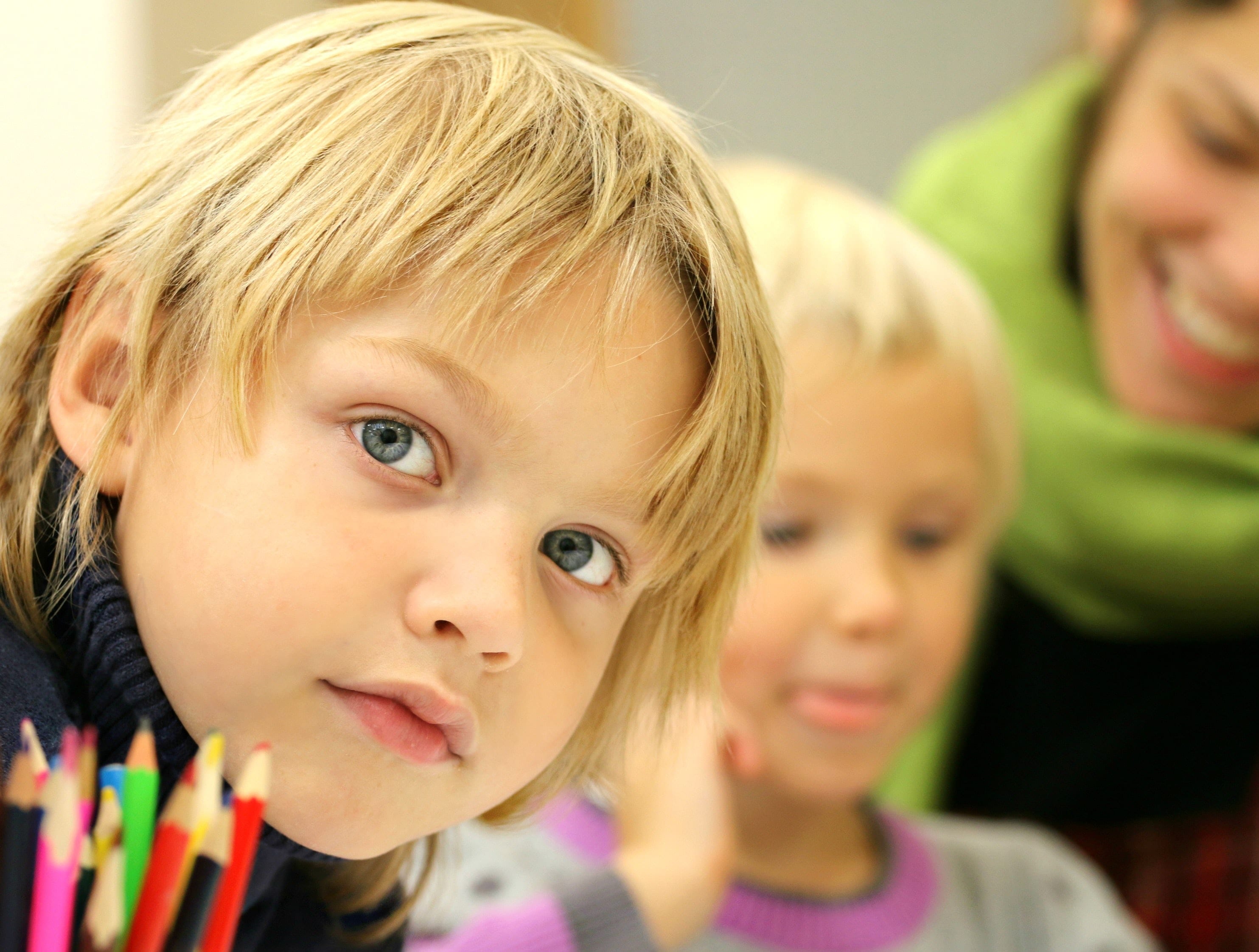Shy Beth
Whenever someone speaks to Beth at preschool, she quickly looks down, turns away, and doesn’t say anything. Her teacher has been hoping that Beth would warm up and interact more with the other members of the class, but weeks have passed and her behaviour hasn’t changed. What’s going on? Well, Beth may be shy.
What is shyness?
Almost all children act shy at times, especially when encountering a new person or situation. Quite sensibly most children take time to figure out what to do (and not do!) when presented with a novel situation. With time, most children start to feel comfortable in a new situation or with a person they’ve recently met and, therefore, act more outgoing, relaxed, and spontaneous. Some children, however, warm up much more slowly than others.
Children who are shy may not respond when spoken to by a teacher or classmate even after weeks of school. Or they may say little, speak very softly, and avoid eye contact. These children may hover near other children day after day but never join the others in play. Shy children may look tense or distracted in school as they worry about becoming the center of attention or doing something embarrassing. Teachers never see the children at home smiling, laughing, and chatting away with family members.
What are the signs of shyness in a young student?
Shy children tend to show at least 3 or 4 of the following behaviors in preschool or primary school. Shy children tend to:
- Produce little or no voluntary speech
- Follow directions but don’t respond verbally to them
- Turn away when spoken to
- Watch but don’t join other children in fun activities
- Make little or no eye contact
- Speak softly
- Volunteer last and line up last for activities.
There are four possibilities, each much less likely than true shyness. In close cases, a expert’s opinion might be useful. The four problems that might look like shyness are:
- Unidentified deafness. Consider this possibility if the child does not respond in any way to loud noises or someone calling her name behind her. A teacher calling, “Lisa, stop!” behind Lisa while Lisa is walking will bring a behavioral response in a shy child but not a deaf one.
- Undiagnosed autism. Consider this possibility if the child shows bizarre behavior such as hand flapping or repeating some other movement again and again, has frequent tantrums, or often makes unintelligible sounds. In general, shy children act normal other than when they are in specific social situations.
- Undiagnosed depression. Consider this possibility if the parents, when asked, say that the child usually acts or looks depressed or distressed at home. Shy children usually look and act happy and confident at home.
- Unidentified speech delay. Consider this possibility if the child tries to speak and joins the other children in activities and volunteers and lines up as fast as the others. Shy children speak normally at home, so if the parents, when asked, say that the child does not speak clearly at home, the problem is more likely speech delay than shyness.
What are the effects of shyness?
The unfortunate effects of being shy include nervousness, decreased development of close relationships, interference with learning, and reduced opportunities to practice and improve social skills. As a shy child reaches 9 or 10 years of age, peers tend to start thinking of the child as not normal. This can in turn have negative effects on the child’s self-esteem. On the other hand, shy children tend to act out less than other children do, perhaps because they don’t want to call attention to themselves by doing something wrong. Although some children outgrow shyness as they get older, others remain painfully shy their entire life.
What can teachers do to help?
Teachers can have a negative or positive effect on shy children. Teachers who interpret shy behaviour as wilful or spiteful may punish the child for remaining silent when asked to sing or to speak. Punishing shy behaviour makes no more sense than punishing urination accidents. It is more likely to cause emotional harm to the child than to help the child develop.
Teachers who view helping children become more outgoing as a developmental project similar to helping the children learn to read or share toys may have quite a positive impact on shy children.
Nine strategies to help shy children become more outgoing
Teachers can use the following nine strategies to help shy children become more outgoing:
- Put children in pairs or other small groups and lead them into an activity that requires interaction.
Put children in pairs or other small groups and lead them into an activity that requires interaction. Here are a few examples for young children: Pair students and ask them to hold hands when they go somewhere outside class. Ask two children to play together one day. With two or three students, play a group game, such as emotions charades, or a fantasy game, such as firefighters working together to rescue someone.
- Prompt interaction between children.
Prompt interaction between children. One way to do this is to give the shy child the words to say to another person, for example, “Juan, ask that boy what his name is.” Or, “If you don’t know the answer to a question, you can say, ‘I don’t know.'” Or, “Say that you want to play too.” If speaking by a shy child is out of the question for the moment, encourage nonverbal communication. Waving hello is much better than making no response to a greeting. Another way of prompting involves talking to one child and to another in a way that encourages them to talk together. For instance: “Christine, I see that you’re pretending to be a doctor. Ben makes a great patient. Ben, tell the doctor where you hurt.” Or: “Jizreel, you have a dog and Nickie does. Tell her your dog’s name.” This approach is similar to serving as a good party host!
- Give shy children plenty of time
Give shy children plenty of time to respond to questions or to speak to the class. Don’t rush to speak for them, for instance, during show-and-tell. Be patient — it may take them a while to overcome their nervousness and speak. If the child doesn’t answer after a period of several seconds, go on pleasantly to the next child or activity.
- Show empathy and understanding.
Show empathy and understanding. By commenting in a caring way on a shy child’s apparent emotion, such as nervousness or embarrassment, you can help the child learn to identify those emotions. By talking about similar emotions you experienced either recently or when you were a child, you can show the child that the emotions are OK and that it is all right to talk about them. Identifying and talking about the emotions may help the child control them.
- Show warmth.
Show warmth. Play with all the children, hug them, compliment them, speak nicely to them, and show interest in them. All children like being treated warmly, but shy children may gain the greatest benefit from being “warmed” up.
- Reward outgoing behavior.
Reward outgoing behavior. Praise children when they interact in a positive way with another person. Set the reward standard lower for a shy child and gradually require more outgoing behavior for praise. So, you might initially praise a shy child for raising three fingers in answer to the question what is one plus two. Later, you might require her to say “three” in order to receive praise. Still, later, you might require her to say “three” appropriately loud to receive praise.
- Avoid labeling.
Avoid labeling. Most children have great hearing when a teacher is speaking about them. Never tell a child that he is “shy.” Labeling creates a risk that the child will think that he is the label and will always be the label. The child will then tend to live out the role. If describing a child’s shy behavior becomes needed, describe it to parents or others with words that are specific, that refer to a past time, and that are hard for the child to latch on to. Say, for instance: “He didn’t speak much today, even when others spoke to him.”
- Read books to the class about characters who overcame shyness.
Read books to the class about characters who overcame shyness. Some of my favourites for preschoolers include:
- Buster the Very Shy Dog, by Lisze Bechtold.
- Chatterbox Jamie, by Nancy Evens Cooney
- Gretchen Groundhog, It’s Your Day, by Abby Levine.
- Speak up, Blanche! by Emily Arnold McCully.
My favourites for primary school students:
- The Shy Little Girl, by P. Krasilovsky
- The Playground, by D. Wilmer
See Helping Young Children Overcome Shyness for more related books. The best way to use such books is as a springboard to a discussion of feeling or acting shy and what children can do to reach out to another child, such as inviting the child to play.
- Team up with parents.
Team up with parents. Work out a consistent plan with parents about how to help a child become more outgoing. Parents can do many things to help a child act more outgoing at school, including following the suggestions above. Parents can also arrange play dates with another child in the class and set a model of talking with the other children and the teachers. Teachers can also refer parents to information specifically written to guide parents of shy children, such as my blog post, “Helping Young Children Overcome Shyness.”
See Davies (undated) for other ideas.
Measuring Progress
How can teachers tell if their efforts are helping a child act more outgoing? If the teachers, child, and parents set specific behavioural goals for the child, such as speaking when spoken to at school or playing with another child, and then keep a daily record of the behaviour, everyone involved can tell when the child makes progress. Be sure to share any signs of progress with parents.
Outgoing Beth
Month after month, Beth, the preschooler described at the start of this article, didn’t respond when the teacher greeted her in the morning. Then, on the last day of the school year, Beth responded with a hello. The lion roared, one might say, and the teacher threw up her hands and screamed with delight. Teaching has its rewards.




Thank you for this article! It was very helpful to me.